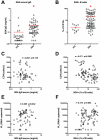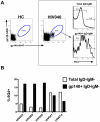9G4 autoreactivity is increased in HIV-infected patients and correlates with HIV broadly neutralizing serum activity
- PMID: 22530008
- PMCID: PMC3329433
- DOI: 10.1371/journal.pone.0035356
9G4 autoreactivity is increased in HIV-infected patients and correlates with HIV broadly neutralizing serum activity
Abstract
The induction of a broadly neutralizing antibody (BNAb) response against HIV-1 would be a desirable feature of a protective vaccine. Vaccine strategies thus far have failed to elicit broadly neutralizing antibody responses; however a minority of HIV-infected patients do develop circulating BNAbs, from which several potent broadly neutralizing monoclonal antibodies (mAbs) have been isolated. The findings that several BNmAbs exhibit autoreactivity and that autoreactive serum antibodies are observed in some HIV patients have advanced the possibility that enforcement of self-tolerance may contribute to the rarity of BNAbs. To examine the possible breakdown of tolerance in HIV patients, we utilized the 9G4 anti-idiotype antibody system, enabling resolution of both autoreactive VH4-34 gene-expressing B cells and serum antibodies. Compared with healthy controls, HIV patients had significantly elevated 9G4+ serum IgG antibody concentrations and frequencies of 9G4+ B cells, a finding characteristic of systemic lupus erythematosus (SLE) patients, both of which positively correlated with HIV viral load. Compared to the global 9G4-IgD--memory B cell population, the 9G4+IgD--memory fraction in HIV patients was dominated by isotype switched IgG+ B cells, but had a more prominent bias toward "IgM only" memory. HIV envelope reactivity was observed both in the 9G4+ serum antibody and 9G4+ B cell population. 9G4+ IgG serum antibody levels positively correlated (r = 0.403, p = 0.0019) with the serum HIV BNAbs. Interestingly, other serum autoantibodies commonly found in SLE (anti-dsDNA, ANA, anti-CL) did not correlate with serum HIV BNAbs. 9G4-associated autoreactivity is preferentially expanded in chronic HIV infection as compared to other SLE autoreactivities. Therefore, the 9G4 system provides an effective tool to examine autoreactivity in HIV patients. Our results suggest that the development of HIV BNAbs is not merely a consequence of a general breakdown in tolerance, but rather a more intricate expansion of selective autoreactive B cells and antibodies.
Conflict of interest statement
Figures





References
-
- Simek MD, Rida W, Priddy FH, Pung P, Carrow E, et al. Human immunodeficiency virus type 1 elite neutralizers: individuals with broad and potent neutralizing activity identified by using a high-throughput neutralization assay together with an analytical selection algorithm. J Virol. 2009;83:7337–7348. - PMC - PubMed
Publication types
MeSH terms
Substances
Grants and funding
LinkOut - more resources
Full Text Sources
Other Literature Sources
Medical

